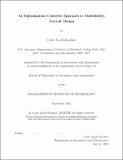An Optimization Centered Approach to Multifidelity Aircraft Design
Author(s)
Karcher, Cody Jacob
DownloadThesis PDF (36.42Mb)
Advisor
Drela, Mark
Terms of use
Metadata
Show full item recordAbstract
A common thread across all of engineering is the concept of design optimization. When a new product is in development, it is the job of the design team to ensure the final result performs well as measured by some set of evaluative criteria, and design decisions are made throughout the process in an effort to maximize this final performance objective. Parallel to this idea is the notion of numerical optimization, where various mathematical methods are used to construct closed form optimization problems that are then solved using computing re- sources. The past few decades have seen extensive effort at applying numerical optimization to design optimization given their similar nature, and in aircraft design these efforts are pri- marily categorized as techniques of Multi-Disciplinary Analysis and Optimization (MDAO). For a number of compelling historical reasons, the MDAO community tends to assume the presence of large integrated analysis models that are pieced together in an MDAO frame- work before being integrated with numerical optimization. But recent work has begun to challenge this approach, instead assuming that aircraft design problems are fundamentally compatible with a fast and efficient form of optimization called Geometric Programming (GP) and adapting all analysis models to fit this form. Both the analysis centered (MDAO) and optimization centered (GP) approaches have considerable merit, but to date remain fundamentally incompatible. This work takes the best elements from both approaches, the efficient mathematical structure from GP and the natural ability to integrate existing black box analysis models from traditional MDAO, and develops two new optimization algorithms that enable an optimization centered, multifidelity approach to aircraft design. The new al- gorithms are benchmarked against a current state of the art algorithm using a set of example problems, and the new design approach is applied to two representative aircraft design case studies.
Date issued
2022-09Department
Massachusetts Institute of Technology. Department of Aeronautics and AstronauticsPublisher
Massachusetts Institute of Technology